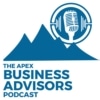Case Study #85: Acquired for $15M with 15 Employees
 Any entrepreneur who takes the leap into healthcare or health technology, especially with no prior experience in the industry, usually does so in response to a tragedy. That was the case for Aaron Leibtag and Steven Aviv when they created Pentavere Research Group, a digital healthcare company.
Any entrepreneur who takes the leap into healthcare or health technology, especially with no prior experience in the industry, usually does so in response to a tragedy. That was the case for Aaron Leibtag and Steven Aviv when they created Pentavere Research Group, a digital healthcare company.
When Steve’s mother passed away unexpectedly due to a data error, the pair built AI-powered software that can identify patients who may not be receiving the care that they need due to the information being buried in a patient’s electronic health record.
Despite only having 15 employees at the time, the company received an acquisition offer for a whopping $15 million.
The Idea
Aaron has a background in finance and spent some time on the private equity side, evaluating consumer-facing companies to drive better results. As such, he has an appreciation for what happens when you combine great data with great people and great processes.
His co-founder, Steven Aviv also spent some time in finance but on the technical side, building large financial systems that ingest data. One day, his mother went into what should have been a routine procedure. Based on her comorbidities (coinciding diseases), she needed to be put on a certain medication. This information was missed by her care team because it was buried in a clinical note and she passed away as a result.
Both Aaron and Steve were at the point in their corporate careers where Steve in particular was helping companies make millions of dollars every day by analyzing data. When such a catastrophic event — that could have been prevented through analyzing data — happened to Steve’s mother, they started to do some research. They found that the majority of patients fall through the cracks in some way, shape, or form within healthcare.
While not every patient experiences such a catastrophic event, many don’t receive the proper treatments, medications, and interventions. So, Aaron and Steve decided to fill in that gap and build something to help.
They built an AI engine that can ingest and read clinical notes within an electronic health record that a doctor dictates to identify patients who are falling through the cracks in healthcare systems. In layman’s terms, they’re able to take all of that clinical text and turn it into a structured Excel spreadsheet-like data set that can be used to improve healthcare.
Once they had the product, they validated the technology by getting the outcomes published in high-impact peer-reviewed journals that matter in healthcare. Now, they were ready to bring it to the market.
The Business Model
Aaron and Steve didn’t know what the business model for their product would be. They simply knew that the industry was large, and the problem was great.
Unlike other digital health companies — when they were growing it was the heyday of venture capital raising — they went to one of Toronto’s largest hospitals to really understand the problem.
They say that they got lucky and were approached by people on the medical side of pharmaceutical companies who themselves are trying to find real-world evidence to understand how their medications were working. The companies were willing to fund the project so they would have access to the findings.
Six months later Aaron and Steve presented their results at the most prestigious lung cancer conference in the world in Barcelona. Soon, more pharmaceutical companies started to call asking them to do similar studies.
The money from those studies helped to fund their R&D and validate their AI engine, but say that at that point there still wasn’t a product or a business model. That said, it was a step in the right direction and both Aaron and Steve knew they had come up with something valuable — and needed in the industry.
The Acquisition
Aaron and Steve began to consider an acquisition when they had over 19 high-impact peer-reviewed publications validating their engine — a claim that not even companies like Google have.
It hit home for them when they got a call that they were nominated for a Prix Galien, the equivalent of the Nobel Prize in the life science industry. They were also told that there was only a very short list of other AI companies with the same criteria as theirs. So, Aaron and Steve decided that this was the time to commercialize and scale.
To do so, they didn’t just need capital, they also needed access to data. The right partners with the right mindset were the missing pieces to the puzzle. It wasn’t so much about an exit, it was trying to find a like-minded partner.
When they tried the venture capitalist route, all it brought them was capital but no data. What’s more, they didn’t really like the idea of giving up control of the company, no matter how much money someone was willing to put down. They wanted — and needed — to partner with someone with the same goals, mission, and values (to improve healthcare) and they just didn’t find that with VCs.
That’s when they began talking to Healwell AI, a healthcare technology company also based in Canada. They were willing to open up their data ecosystem and give them the funding they needed. Healwell is also a publicly traded company and has a strategic alliance with WELL Health, the largest private provider of healthcare in Canada.
It was an easy yes.
Key Lessons
- Uninspired? Identify market gaps. Aaron and Steve recognized a significant gap in healthcare where patients were not receiving proper treatment. This realization led them to develop a solution that could identify and address these gaps. If you want to build a business but aren’t sure where to start, pick an industry and figure out what it’s missing.
- Create, tweak, validate. Before bringing their product to market, Aaron and Steve validated their technology by getting outcomes published in high-impact peer-reviewed journals. Yes, they were required to due to the nature of their product and the industry, but there’s something to be learned here. Come up with your own system of validation to determine whether your idea is viable, and then be willing to tweak it if needed.
- Seek strategic partnerships. Aaron and Steve first went to VCs but quickly discovered they wouldn’t likely find their ideal partner there. Rather than giving up, they sought out companies that had the same mission, values, and goals as they did. Their patience and due diligence paid off.
Although it operates under the Healwell umbrella, 48% of the company still belongs to Aaron, Steve, and the other original shareholders. The final Letter of Intent was signed on September 22, they announced the definitive documents signed to the public markets on November 15, and closed the transaction on December 1, all for a cool $15 million.
Aaron and Steve are still very much involved in the day-to-day operations post-acquisition, and Healwell’s stock went up 30%. It’s safe to say everyone made it out a winner.
If you’re ready to take your business to the next level and aren’t sure whether an exit or an acquisition is your best bet, we can help. Give us a call today to talk about your options.


